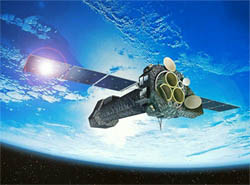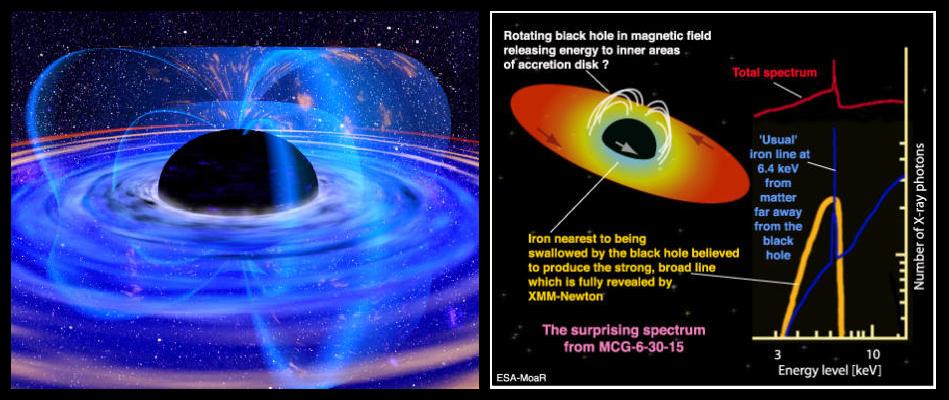






Selected Articles from the
November 2001 Odyssey
Editor: Terry Hancock
- Mars Odyssey Infrared Images, NASA
- First Observation of Black Hole Energy Extraction, NASA
- The Surf Report, Diane Rhodes
ESA's XMM-Newton Makes First Observation of Black Hole Energy Extraction Mechanism
NASA Press Release
 |
| Artist's conception of XMM-Newton spacecraft in flight. NASA/ESA |
Scientists for the first time have seen energy being extracted from a black hole. Like an electric dynamo, this black hole spins and pumps energy out through cable-like magnetic field lines into the chaotic gas whipping around it, making the gas - already infernally hot from the sheer force of crushing gravity - even hotter.
Joern Wilms of Tuebingen University, Germany, and an international team of astronomers observed the novel ``power tapping'' with the European Space Agency's X-ray Multi-Mirror Mission (XMM-Newton) satellite by watching a supermassive black hole in the core of galaxy named MCG-6-30-15. The observation also may explain the origin of particle jets in quasars.
Scientists say most galaxies, including our Milky Way galaxy, have a supermassive black hole at their core. A supermassive black hole contains the mass of millions to billions of Suns compressed within a region smaller than our solar system. The black hole in MCG-6-30-15, over 100 million light-years from Earth, has the mass of about 100 million Suns.
The team observed the X-ray glow of iron gas traveling about half the speed of light very close to the black hole in MCG-6-30-15's event horizon, the theoretical border of a black hole. XMM-Newton captured the spectrum of this gas.
 |
| Artist's conception of MCG-6-30-15. Jörn Wilms (Tübingen) et al.; ESA. Click to enlarge. |
The total energy output, or luminosity indicated by the spectrum, was too bright to be powered by gravity and the free fall of matter alone. Some additional power source must exist to boost the luminosity to the observed intensity.
This finding may be observational evidence of a theory by Prof. Roger Blandford and Dr. Roman Znajek, from over 25 years ago. According to that theory, rotational energy can be extracted from the black hole as it is braked by magnetic fields. The first law of thermodynamics (conservation of energy) states that energy lost from the black hole must be absorbed by the region.
Theoretically, the energy lost in MCG-6-30-15 is transferred to the inner edge of the accretion disk, a flow of gas swirling around and eventually falling into the black hole. The Blandford-Znajek theory implies that energy flows to particle jets emanating perpendicularly from the accretion disk in quasars (quasars have long been believed to be powered this way). MCG-6-30-15 is not a quasar, but Begelman said the theory can still apply because it predicts that the magnetic field might also link to the disk.
ASCA, a Japanese X-ray satellite, found possible evidence of a spinning black hole in 1994, but the signal was too weak to observe any evidence of energy being extracted from the black hole.
XMM-Newton, launched from French Guiana by ESA in December 1999, carries three advanced X-ray telescopes with the light-collecting ability to detect millions of sources, far greater than any previous X-ray mission. NASA helped fund mission development and supports guest observatory time. NASA's Goddard Space Flight Center, Greenbelt, Md., hosts the U.S. guest-observer support center.
To learn more about the XMM-Newton and other high energy astrophysics missions, visit the Goddard Space Flight Center HEASARC Education and Outreach site.
File translated from TEX by TTH, version
2.25.
On 27 Jan 2002, 21:43.
Copyright © 1998-2003 Organization for the Advancement of Space Industrialization and Settlement. All Rights Reserved.